|
|
|
|
|
English
|
Japanese
|
Chinese
|
Sanskrit / Pali
|
Korean
|
Tibetan
|
|
Lord of Wisdom
Voice of the Law
Patron of
Calligraphers
and Students
|
Monju 文殊
Monjushiri 文殊師利
Manjushiri 曼殊室利
Myōkichijō 妙吉祥
|
Wén Shū 文殊
Wenshu
Wen-shu
文殊菩薩
Wénshū Púsà
|
मञ्जुश्री
Manjusri
Manjushri
Mañjuśrī
Mañjughosha
Mañjunātha
Mañjudeva
|
Munsu
문수
|
Jam pal, Jam-dpal, Jam pal yang, Jam pal tsan chu
|
|
|

Monju Bosatsu 文殊菩薩
Personifies Wisdom, The Voice of Buddhist Law
Wisest of the Bodhisattva. In modern Japan, students
pay homage to Monju in the hopes of passing school
examinations and becoming gifted calligraphers.
- Origin = India
- Appears in the Lotus Sutra (Hokekyō 法華経; Skt. Saddharma Puṇḍarīka), the Wisdom Sutra (Hannyakyō 般若経; Skt. Prajnaparamita), the Yuima Sutra (Yuimakyō 維摩経; Skt. Vimalakirtinirdesa), and in numerous other Mahayana texts
- One of Four Great Bodhisattva of Asia
- One of 13 Deities 十三仏 (Jūsanbutsu) of the Shingon Sect of Esoteric Buddhism (Mikkyō 密教) in Japan; in this role, Monju presides over the memorial service held on the 21st day following one's death.
- Monju is a deity of the kitchen or dining halls in Japan's Tendai 天台 sect and known as Sōgyō Monju 僧形文殊; also see our site page about Japan’s various kitchen deities.
- Monju is the deity of meditation halls in some Zen temples, wherein the diety is known as Shōsō Monju 聖僧文殊.
- Associated with Japanese monk Gyōki 行基
- Associated with Yuima 維摩 (Skt. = Vimalakirti), an Indian Buddhist layman who is visited by Monju; the two have a conversation, and Yuima displays a superior understanding of Mahayana principles; their conversation was a popular theme in Japanese sculpture and painting.
- Portrayed sometimes as a youth; represents "eternal youth"
- Served by five messengers (Monju Goshisha 文殊五使者) and eight young attendants (Hachidai Dōji 八童子); often depicted in art in the Monju Gosonzō 文殊五尊像 (lit. Monju Quintet), composed of Monju and four attendants (Shikenzoku 四眷属). Well-known extant statues are housed at Monjuin 文殊院 and Saidaiji 西大寺 (both in Nara).
- Appears in popular art form known as the Shaka Triad (Shaka Sanzon 釈迦三尊), with Historical Buddha positioned in the center, with Monju at left and Fugen at right
- Often depicted with five curls in hair (sometimes with one, three, six, or eight). The five symbolize the five wisdom peaks 五智 of China’s Mt. Wutaishān 五臺山 (also known as Qīngliáng Shān 淸涼山; Jp. Godaisan), Monju’s holy mountain in China. It is a popular pilgrimage site even today. Gokei Monju Bosatsu 五髻文殊菩薩 means Monju with Five Topknots (or five chignon). An excellent extant example is located at Hōryūji Temple 法隆寺 in Nara. See here for Chignon details.
- In Japan, often depicted holding the sword of wisdom in right hand (to cut through illusion and shed light on the unenlightened mind) and sitting atop a roaring lion, which symbolizes the voice of Buddhist Law and the power of Buddhism to overcome all obstacles. Monju’s left hand often holds a sutra representing the Hannyakyō 般若経 (Perfection of Wisdom Sutra; Skt = Prajnaparamita Sūtra) or a blue lotus. Other artwork shows Monju riding a peacock or sitting on a white lotus.
- Monju’s cult was introduced to Japan by Ennin 円仁 (794-864), a Japanese monk who visited Wutaishan during his travels in China between 838 and 847.
- Appears in both the Womb World Mandala (Jp. = Taizōkai) and Diamond World Mandala (Jp. = Kongōkai) of Japan’s esoteric sects. In the Taizōkai (Skt. Garbhadhātu), Monju appears in the Monju-in 文殊院 section holding a lotus surmounted with a three-pronged vajra in left hand, and also in the central Chūdai Hachiyō-in 中台八葉院 section holding a sutra in right hand and a lotus surmounted with a five-pronged vajra in the left. In the Kongōkai Mandala (Skt. Vajradhatu), Monju is identified with Kongōri 金剛利 (Skt. Vajratiksna), one of 16 Great Bodhisattva.
- Appears also in artwork known as the Tokai Monjuzō 渡海文殊像 or Monju Tokai-zu 文殊渡海図 (lit. = Monju Crossing the Sea), in which Monju and entourage are shown on clouds crossing the sea in the direction of Wutaishan. Such a painting (a national treasure) from the Kamakura era is housed at Daigoji 醍醐寺 in Kyoto. <Source: JAANUS> For an example of Tokai Monju in sculpture, see photo below.
- Zodiac Patron of People Born in the Year of Rabbit.
Click here to find your patron deity.
English Translations for Monju
- Begetter of Understanding
- Guardian of the Law, Voice of the Law
- Bodhisattva of Supreme Wisdom and Beautiful Splendor
- One Who Shows the Holy Way
- One of Marvelous Virtue and Gentle Majesty
- One with a Marvelous Voice (to Speak of the Law)
- Father and Mother of the Various Bodhisattva
Other Chinese, Japanese, & Sanskirt Spellings
- Transliterations 文殊師利, 滿殊尸利, 曼殊室利, 滿祖室哩
- Translations 妙吉祥, 妙德, 妙樂, 法王子
- Myōkichijō 妙吉祥 (Jp.); means wonderful & auspicious one
- Myō-on 妙音 (Jp. for Mañjughosha; means wonderful voice)
- Manjughosha, Manjunatha, Manjudeva, Myoukichijou, Myo-on
|
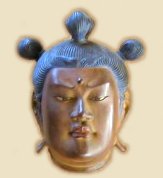
Modern Monju Mask, this J-site

MANTRA IN JAPAN
“On (Om) Arahashana.”
Six-Sound Japanese Mantra.
There are various mantras of
one, five, six, and eight sounds
known as the Ichiji Monju
一字文殊 (one-letter Monju),
Goji Monju 五字文殊 (five-letter
Monju), Rokuji Monju 六字文殊
(six-letter Monju) and Hachiji Monju
八字文殊 (eight-letter Monju).
Says JAANUS: “Ichiji Monju,
for example, guards against
natural disasters & nightmares.”
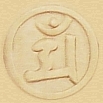
Monju’s Sanskrit Seed Syllable
MAN - Japanese pronunciation
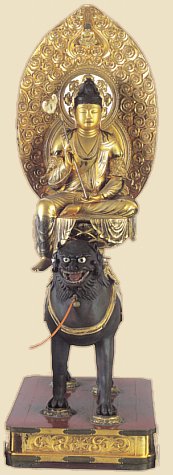
Monju riding the mythical Shishi
12th century, Treasure of Chūsonji
Photo courtesy of magazine
Nihon no Bi no Meguru #35
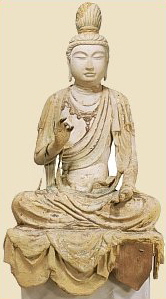
Monju, 7th Century
Hōryūji Temple (Nara)
|

Overview. Monju was a disciple of the Historical Buddha, and represents wisdom, intelligence and willpower. In Mahayana traditions throughout Asia, Monju is the personification of the Buddha's teachings, and hence Monju symbolizes wisdom and the enlightened mind. Monju is considered the wisest of the Bodhisattva, and thus acts as the Voice (Expounder) of Buddhist Law. Monju enjoyed vast popularity in Asia for many centuries. But today in China and Japan, Monju's popularity has diminished somewhat among the common folk. Nonetheless, Monju is still counted as one of the most popular of all Mahayana divinities. In Japan, students pay homage to Monju in the hopes of passing school examinations and becoming gifted calligraphers.
In Theravada traditions, Monju corresponds to Śāriputra (Shariputra), one of the ten disciples of Shaka Buddha (the Historical Buddha). Śāriputra was considered the wisest of the ten disciples. In Mahayana traditions, Monju Bodhisattva supplants Shariputra, and is thus known as the "begetter of understanding." Monju appears prominently in the Manjusri Parinirvina Sutra, and is considered the father and mother of the Bodhisattva.
Monju is often represented in artwork in India, Tibet, China, Japan, and Nepal -- by tradition, Monju founded Nepal upon his arrival from China. Monju’s images appear only late in the sixth century AD in Central Asia and on a few Chinese stele associated with Vimalakirti (Japanese = Yuima Koji).
Japanese sculptures of Monju often depict the deity sitting atop a roaring lion or shishi, which symbolizes the voice of Buddhist Law and the power of Buddhism to overcome all obstacles. Shishi are also commonly found guarding the entrance gate to shrines and temples. Monju typically holds the Sutra of Wisdom in the left hand and a sharp sword in the right, which Monju uses to cut through illusion and shed light on the unenlightened mind. In some artwork, Monju carries a lotus flower and sits atop a shishi (mythical lion).

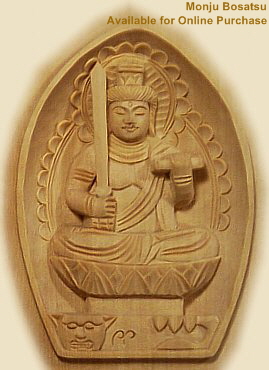 Introduction to Japan Introduction to Japan
Monju's cult was introduced to Japan by Ennin 圓仁 (794-864 AD; also spelled 円仁), a Japanese monk who visited Wutaishan (a five-terraced mountain in China's Shanxi Province that today is still a major center of the Monju cult) during his travels to China (838-847 AD).
Monju symbolizes wisdom and the enlightened mind (realization), and is often paired with Fugen Bosatsu, who in contrast represents meditation and practice (praxis). In Japanese artwork, Monju and Fugen are often shown flanking the Historical Buddha in a grouping called the Shaka Trinity (Jp. = Shaka Sanzon), with Monju situated on the left of the central Shaka statue and Fugen placed on the right. In this grouping, Monju is the Guardian of Wisdom (the voice of exposition) and Fugen the Guardian of the Law (the holder and practitioner of Buddhist Law). See triad image below. Another triad image is found on the Fugen Page.
In addition, in Asia, there is a Mahayana grouping called the Four Great Bodhisattva, with each of the four symbolizing a specific aspect of Buddhism. They are Kannon Bosatsu (compassion), Monju Bodhisattva (wisdom), Fugen Bosatsu (praxis), and Jizō Bosatsu (vast patience and salvation from suffering).
Monju can be traced back at least to the 4th century AD in China. Monju appears frequently in the Lotus Sutra, in which Monju converts the eight-year-old daughter of the Dragon King Sagara to Buddhism. She gains enlightenment, and illustrates the universal possibility of Buddhahood for both men and women. Monju is also sometimes portrayed with four messengers (Shikenzoku 四眷属) and eight youthful attendants (Hachidai Dōji 八童子), or crossing the sea (tokai渡海) with four attendants (see photo immediatelybelow).
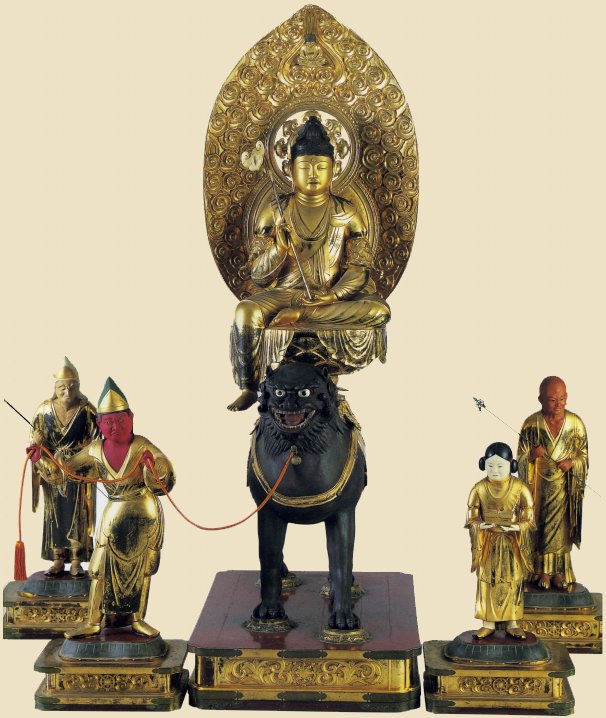
ABOVE: Kishi Monju 騎獅文殊 atop shishi lion and served by Four Attendants 四眷属 (Shikenzoku).
Wood, Central Monju H = 70.6 cm, 12th century. Chūsonji Temple 中尊寺 (Iwate Prefecture) surrounded by
Zenzai Dōji 善財童子 56.5cm, Utennō 優填王/于門王 75.7cm, Butsudahari 仏陀波利 69.9cm, Daiseija-nin 大聖者人 74.8cm.
Supposedly the oldest extant statues of Monju & the Four. See Iwate Cultural Heritage
References: List of National Cultural Heritage in Hiraizumi (English) or Cultural Treasures of Iwate Prefecture (Japanese)
Most likely built in order to protect and preserve "So-Han-Issaikyo Sutra" which was dedicated by Motohira (deceased 1157), the second lord of Oshu Fujiwara family. It is the oldest example of the images of Monju-five-statues manifested at Mt. Godaisan, China. Also, it is a precious example of statues employing Gyoku-gan (crystal eyes), which came to prominence in the following Kamakura period. for details.
Photo scanned from Japanese magazine 日本の美をめぐる, No. 35, 2002
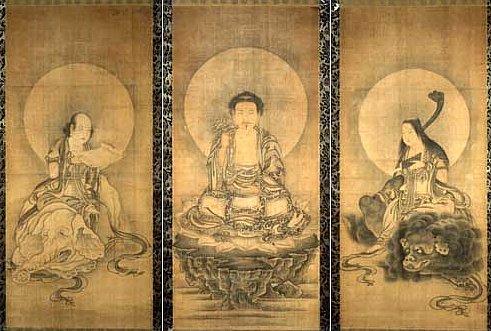
Tōkōji Temple 東光寺 (Hagi, Yamaguchi Prefecture). Zen temple founded in 1691.
Painting. H = 97 cm, W = 44 cm. Late Muromachi era. Photo this J-site.

Monju Iconography in Japan
Monju comes in many forms throughout Asia. In Japan, Monju is often portrayed with the Sutra of Wisdom in the left hand, a sword in the right hand to cut through illusion (to shed light on the unenlightened mind, to disperse the clouds of ignorance), and sitting atop a roaring lion, which symbolizes the voice of Buddhist Law and the power of Buddhism to overcome all obstacles. This riding-lion form is also known as the Kishi Monju Bosatsu 騎獅文殊 in Japan (see photo above). Monju is frequently represented with five curls or knots (chignons) of hair, indicating the five-terraced mountain (Ch. = Wutaishan, Jp. = Godaisan) in China where Monju is venerated, or the Fivefold Wisdom of Dainichi Buddha, which corresponds to the five kinds of wisdom important to the Shingon sect, which in turn relates to the five elements of earth, water, fire, air (wind), and space (ether). Indeed, in Japan's Esoteric sects, Monju appears in both the Womb World Mandala (Jp. = Taizōkai) and the Diamond World Mandala (Jp. = Kongōkai).
Monju is counted among the 16 Great Bodhisattva and the 13 Deities of the Shingon School. In the latter grouping, Monju presides over the funeral service held on the 21st day after one's death. Other forms of Monju are based on the number of syllables (one, five, six, or eight) in the specific mantra being chanted to Monju. The single-sound mantra, for example, is said to protect against nightmares and natural disasters. There are other forms as well, those based on the number of hair knots (one, five, six, or eight), with each providing protection against different dangers.
In Japan's Tendai sect, Monju is enshrined in temple dining halls as a deity of the kitchen, and in Zen temples in the meditation halls. There is also an '"Infant Monju" (Jp. = Chigo Monju 稚児文殊), for Monju represents "eternal youth" in some traditions and is thus portrayed as perennially young. This latter version of Monju is known as Kumarabhuta in Sanskrit, meaning "youthful." There is also a "rope-robed" Monju and a form of Monju in the guise of a monk (Sōgyō Monju 僧形文殊).

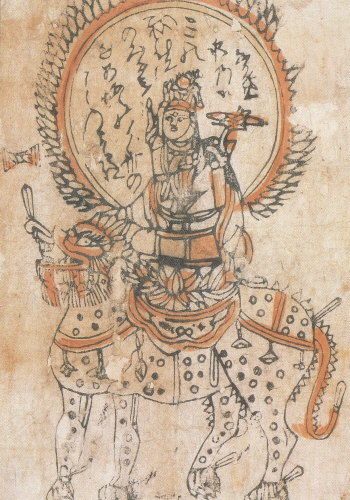
Buddhist Woodblock Print
www.mingeikan.or.jp/english/html/painting-pt_11.html
Monju Bodhisattva -- God of Wisdom and Intellect
Edo Period, 17th Century, Length 32 cm.


|
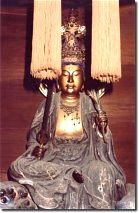
Monju
Treasure of Myoshin-ji, Kyoto
Photo courtesy http://zen.art.pl
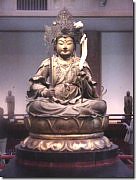
Monju, Kamakura Era
Treasure of Saidai-ji (Nara)
|
|
Eight Great Youths, Hachidai Dōji 八大童子 Text Courtesy of JAANUS. Literally "Eight Great Youths." Eight attendants of either Monju Bosatsu or, more commonly, Fudō Myō-ō. The eight attendants of Monju (Monju Hachidai Dōji 文殊八大童子) are mentioned in several texts, and they appear in the Monju-in 文殊院 of the Taizōkai Mandara 胎蔵界曼荼羅. Their names are:
- Kōmō 光網 (Skt: Jaliniplabha)
- Hōkan 宝冠 (Skt: Ratnamukuta)
- Mukukō 垢光 (Skt: Vimalaprabha)
- Keishini 髻設尼 (Skt: Kesini)
- Ubakeishini 烏波髻設尼 (Skt: Upakesini)
- Shittara 質多羅 (Skt: Citra)
- Jie 地慧 (Skt: Vasumati)
- Chōshō 召請 (Skt: Akarsani)
Five Messengers, Monju Goshisha 文殊五使者
The last five in above list are female and are collectively known as the Five Messengers of Monju (Monju Goshisha). In some texts Fushigie 不思議慧 (Skt. Acintyamati) and Kugoe 救護慧 (Skt. Paritranasayamati) are substituted for Hōkan and Shittara respectively. <end JAANUS quote>

Four Companions, Shikenzoku 四眷属
In artwork, Monju is sometimes accompanied by four attendants (Shikenzoku 四眷属), and this form is known as the Monju Goson 文殊五尊 (lit. = Monju Quintet). The composition of the four attendants sometimes differs. For example, the administrators of the Kishi Monju Quintet in Iwate Prefecture list one of the four as Daiseija-nin 大聖者人, replacing the more common Saishō Rōnin.
- Zenzai Dōji 善財童子 (Skt. = Sudhana Śreṣṭhidāraka), a youth who took a pilgrimage to 53 places wherein he met 55 saints (as described in the Kegonkyō Sutra 華厳経).
- King of Khotan (Jp. = Utennō 優填王 or 于門王; Skt. = King Udayana)
- Elderly Saishō Rōnin or Saishō Rōjin 最勝老人; sometimes given as Daiseija-nin 大聖者人
- Monk Buddhapari (Jp. = Butsudahari or Butsudahari Sanzō 仏陀波利; Skt. = Buddhapāli Tri-piṭaka)
Says JAANUS: Well-known statuary representations of the quintet are at Monju-in 文殊院 and Saidaiji 西大寺, both in Nara. In a variation of this format, called Monju Crossing the Sea (Jp. = Tokai Monjuzō 渡海文殊像, Monju Tokai-zu 文殊渡海図), Monju and his entourage are depicted on clouds crossing the sea (supposedly in the direction of Wutaishan). A painting of this group from the Kamakura period is kept at Daigoji 醍醐寺 (Kyoto) and is designated a national treasure. <end JAANUS quote>
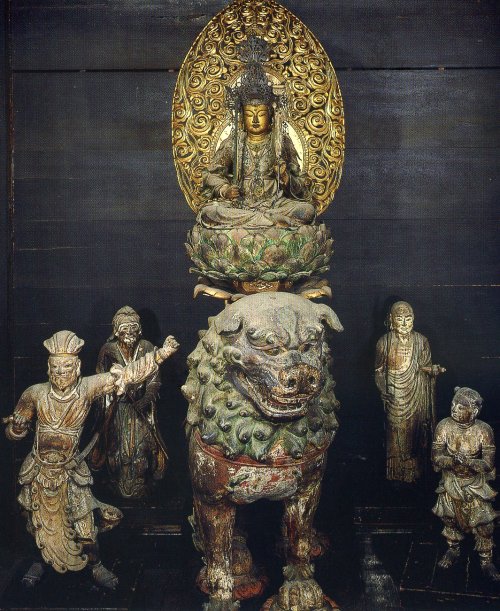
Tokai Monju 渡海文殊 and Four Attendants. Lit. = Monju Crossing the Sea
Wood, H = 82.2 cm, Kamakura Era, 1302. Important Cultural Property
Saidaiji Temple 西大寺 (Nara). Photo scanned from magazine
日本の仏像 (Japan's Buddha Statues), No. 11, Aug. 2007

Japanese Monk Gyōki (Gyoki) 行基
Gyōki (+668-749) descended from from Korean immigrants.
Courtesy www.buddhanet.net/e-learning/history/b_fbodi.htm
Images of Monju were introduced into Japan by Chinese monks who, during a voyage to Wutaishan, learned that Manjusri was reincarnated in the person of the Japanese monk Gyoki 行基, and so went to Nara in 736. One of these Chinese monks, Bodhisena (Jp. = 菩提僊那; +704-760), succeeded Gyoki as director of the Buddhist community of the Todai-ji Temple (Nara) in 751 or 752. In turn, another monk named Ennin (Tendai sect) travelled to China to Mount Wutai in the year 840, during a journey that lasted nine years from 838 to 847, and brought back scriptures and images of Monju Bodhisattva.

More about Monk Gyōki (Gyoki) 行基
Gyōki (+668-749) descended from from Korean immigrants.
Text Courtesy of Takahiro Kondo. The “Great Priest” Gyoki (668-749 AD) was born in Osaka with Korean background and took Buddhist vows at age 15, entering Asukadera in Nara, the oldest temple in Japan founded in 569. Though started as an official priest employed by the government, he was not satisfied with the Buddhism then prevailing in Japan. It was solely for the peace of the state and welfare of the court nobles, not for the masses. He quit the job in 704 at age 36 to propagate Buddhism for salvation of the suffering people and to practice philanthropy, making a pilgrimage mostly in Osaka and Nara areas. Not only did he give a hand to the sick, the poor and many others in distress, he also contributed to social welfare building roads, bridges, irrigation reservoirs and other civil engineering, and helped construct a number of temples. Gradually, he earned fame as a Buddhist and philanthropist. Back at the time, Emperor Shomu (701-756) was reigning Japan and he had a plan to construct a great Buddha statue in Nara. The project was so huge that state funds alone were not enough to cover the total cost. The emperor asked Priest Gyoki to help raise funds. Accepting the emperor's request, Priest Gyoki immediately began fund-raising campaigns. Thanks to his fame and philanthropic activities, enough alms were collected soon afterward, and in 752 casting the Great Buddha statue we see today at Todaiji was completed. Unfortunately, he had passed away just before the consecrating ceremony for the statue took place. Without his self-sacrificing efforts, the colossal statue would not have probably been constructed. In praise of the priest's achievement, the emperor conferred on him the title of Dai-sojo, or the Great Priest, the highest rank given to priests. In addition, people called him 'Gyoki Bodhisattva'. The priest had two honorable titles: the official Dai-sojo and unofficial Gyoki Bodhisattva. Priest Gyōki is also reported to have helped build Sugimoto-dera in Kamakura, although evidence suggests otherwise.

More about Monk Gyōki (Gyoki) 行基. See Gyōki: Bodhisattva of Japan (+668-749) by Ronald S. Green at ronnygreen.us/gyoki.htm. Below is just a brief passage: “To contrast Buddhist traditions, the historian Gyōnen used the classifications jiriki 自力 (salvation by means of one’s own efforts) and tariki 他力 (reliance on the powers of another for salvation). According to the argument above, Gyōki’s Buddhism should be classified as jiriki in contrast to the tariki of Pure Land Buddhism (Amida faith).”

Below Text Courtesy of
www.buddhanet.net/e-learning/history/b_fbodi.htm
Monju Bosatsu, along with Fugen Bosatsu (Samantabhadra), are disciples of the Historical Buddha. In Japan, the two often appear with the Historical Buddha in a grouping called Shaka Sanzon, “the three venerables of Sakyamuni.” Monju represents wisdom, intelligence and willpower. His adoration combines divine wisdom, mastery of the Dharma, an infallible memory, mental perfection, and eloquence. This Bodhisattva, known in India by the doctrines of the Theravada, is identified with the King of Gandharva -- Pancasikha. Monju Bosatsu also appears in many Mahayana texts. The Lotus Sutra assigns him a universe in the east called Vimala. Manjusri is the initiator and master of the Buddhas of past ages, the father and the mother of the Bodhisattvas, and their spiritual friend. The Historical Buddha describes Manjusri and praises him in the Manjusri Parinirvina Sutra. Monjusri is often represented in India and Tibet, in China and Japan, and in Nepal, which tradition claims Manjusri founded upon his arrival from China. His images appear only late in the sixth century in Central Asia and on a few Chinese stele associated with Vimalakirti (Japanese Yuima Koji).
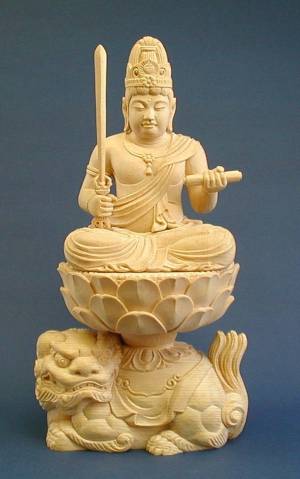
Modern wood carving of Monju on Shishi lion
Carving available for online purchase at www.butsuzou.com

Monju and Yuima 維摩
Below text courtesy of JAANUS. Skt. = Vimalakirti (pure reputation), Ch. = Weimo. Indian Buddhist layman (Ch. = Jushi, Jp. = Koji 居士) famous for his profound understanding of Mahayana principles (Jp: Daijou Bukkyou 大乗仏教). A wealthy and well-educated family man from the central Indian town of Vaisali, Yuima was a paragon of Buddhist virtues despite his worldly attachments. As such, he was a favorite figure with Buddhist people particularly in China and Japan with their strong cultural emphasis on family responsibility. The YUIMAKYOU 維摩経 (Ch:Weimoching, Sk:Vimalakirti-nirdesa) tells of Yuima's life, including the famous incident in which Yuima, lying in a small house, is visited by Monju 文殊 (Sk: Manjusri). The two men have a philosophical debate on the "gateway of the non-dual Dharama" in which Yuima demonstrates his superior understanding. This conversation, known as Yuimakyou Hensou 維摩経変相, was often illustrated in both sculpture and painting. Yuima is typically shown as a bearded old man, seated with one knee raised, wearing a cowl, and holding a fly whisk. Yuima and Monju are depicted in extant early Chinese cave complexes such as Dunhuang (Jp:Tonkou 敦煌, notably in cave #103) and Yonggang (Jp:Unkou 雲崗, cave #6). The hakubyou 白描 painting of Yuima attributed to Li Gonglin (Jp: Ri Kourin 李公麟, 1049?-1106; Tokyo National Museum), along with similar compositions in color, echo the style of now lost Tang period temple wall-paintings. In Japan, a painted clay diorama of the pagoda at Houryuuji 法隆寺, Nara, (858) contains the best-known example of Yuima. Other depictions of Yuima alone include wood sculpture at Hokkeji 法華寺, Nara (8c), and by Joukei 定慶 in Koufukuji 興福寺, Nara. Paintings by Bunsei 文清 (1457; Yamato Bunkakan 大和文華館, Nara), Takuma Eiga 詫磨栄賀 (act. late 14c; Tokyo National Museum), Sesshuu 雪舟 (1420-1506; Daitokuji Kohouan 大徳寺孤篷庵, Kyoto), and Kanou Tan'yuu 狩野探幽 (1602-74; Sengakuji, Miyagi prefecture) demonstrate the popularity of the theme with Japanese artists. <end JAANUS quote>
|
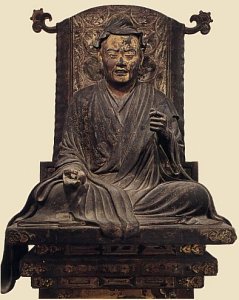
Indian Buddhist Layman Yuima 維摩 by Jokei 1
Dated +1196, H = 88.5 cm.
Kōfukuji Temple 興福寺, Nara. National Treasure.
|
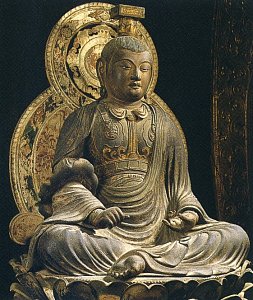
Seated Monju Bosatsu 文殊菩薩 by Jokei 1
Dated +1196, Kōfukuji Temple 興福寺, Nara
Wood, H = 94 cm, National Treasure.
|
|
This statue, together with the Monju statue at right, depict the scene when Monju was sent by Buddha to visit Yuima, who was sick in bed; the two then conversed. Registered
|

SIDE NOTES: Monju & Fugen Nuclear Power Plants
Text courtesy of Takahiro Kondo. Monju and Fugen may remind us of the accidents at a nuclear power plant. Two fast breeder reactors located in Fukui Prefecture were named ”Monju” and ”Fugen.” However, ”Monju“ was temporarily shut down on December 8, 1995 due to a leak of sodium coolant. Ironically, December 8 was the day Sakyamuni attained enlightenment. Also Fugen is supposed to be advanced thermal reactors using both uranium and plutonium as fuel. In 1995, however, the government gave up the plan to develop such reactors in the face of stiff opposition. The reactor, which entered service in March 1979, cost 68.5 billion yen to build, but may cost three times that amount to dismantle it, or 200 billion yen (US$1.5 billion). From the Buddhist viewpoint, naming the reactors 'Fugen' and 'Monju' was blasphemy against the Bodhisattva. Swift is Heaven's vengeance.
MONJU BOSATSU AS KITCHEN DEITY
SAYS THE FLAMMARION GUIDE TO BUDDHISM:
by Louis Frederic, Printed in France, 1995; ISBN 2-08013-558-9
During the Heian period in Japan, a popular custom witnessed the installation of an effigy of Manjusri clothed as a monk (or in a habit made of rope, or a Chinese robe in the Tang fashion) in the kitchens of places of residence, in order to symbolize the wisdom and discipline which should be observed for the maintenance of the home.....but the popularity of his worship subsequently diminished; in Japan today his memory is alive although he is hardly worshipped any more, and very few temples are devoted to him. The most famous of those that are is that of Amano-Hashidate. <end quote> For more on Japan’s various kitchen deities, click here.

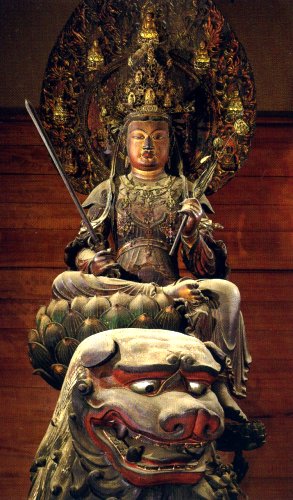
Monju atop Shishi (Lion), surrounded by four attendants (not shown in photo)
Wood, H = 7 meters, Kamakura Era, Important Cultural Property. Carved by Kaikei 快慶
Abemonju-in 安倍文殊院 (Sakurai City, Nara). Photo scanned from magazine
日本の仏像 (Japan's Buddha Statues), No. 29, Jan. 2008

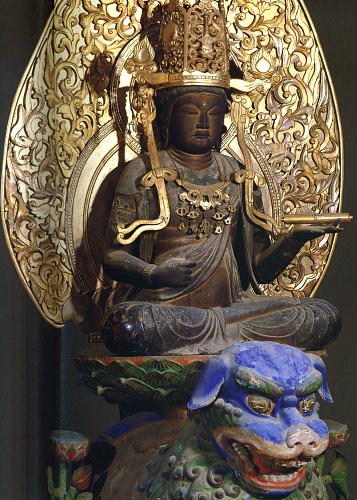
Monju atop Shishi Lion
Wood, H = 110.0 cm, Heian Era, 10th Century. Important Cultural Property.
Seiryōji Temple 清凉寺 (Kyoto). Photo scanned from magazine
日本の仏像 (Japan's Buddha Statues), No. 29, Jan. 2008

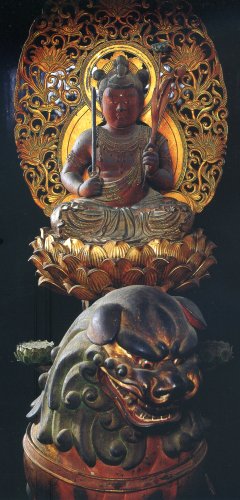
Hachiji Monju Bosatsu 八字文殊菩薩
Monju with Eight Hair Knots (chignons) sitting atop Shishi Lion
Wood, H = 45.5 cm, Kamakura Era, 1324. Important Cultural Property
Hannya-ji Temple 般若寺 (Nara), Carved by Kōshun 康俊. Photo scanned
from magazine 日本の仏像 (Japan's Buddha Statues), No. 32, Jan. 2008

LEARN MORE
- Mage 髷 = Chignon. A topknot associated especially with Monju Bosatsu 文殊菩薩, one that rose to prominence with the emergence of the Shingon 真言 and Tendai 天台 sects of Esoteric Buddhism (Mikkyō 密教) in the Heian period. Monju is frequently represented with five curls or knots (chignons) of hair, indicating the five-terraced mountain (Ch. = Wutaishan) in China where Monju is venerated, or the five kinds of wisdom important to the Shingon sect, which in turn relates to the five elements of earth, water, fire, air (wind), and space (ether). There are other forms of Monju as well, those based on the number of hair knots (one, five, six, or eight), with each form providing protection against different dangers, with Ikkei Monju (one-knot Monju), for example, guarding against still childbirth and rain. The specific Japanese terms for the number of knots include Ikkei Monju 一髻文殊 (one-knot Monju), gokei monju 五髻文殊 (five-knot Monju ), Rokkei Monju 六髻文殊 (six-knot Monju) and Hakkei Monju 八髻文殊 (eight-knot Monju). <Adapted from JAANUS>
- JAANUS: Japanese Architecture and Art Net Users System
Learn more about Monju at this excellent online dictionary.
- Buddhist-Artwork.com
Statues of Monju are available for online purchase at our sister site.

- Says the Digital Dictionary of Buddhism about Monju Bosatsu (C. Muller; sign in with user name "guest"). Six definitions are obtained from various scriptures: 妙首 (or 妙頭; wonderful or beautiful) head; 普首 universal head; 濡首 glossy head (probably a transliteration); 敬首 revered head; 妙德 wonderful virtue (or power); 妙吉祥 wonderfully auspicious; the last is a later translation in the Record of the Journey to Western Lands 西域記.
- Cultural Treasures in Iwate Prefecture, the Monju Quintet
References: List of National Cultural Heritage in Hiraizumi (English) or Cultural Treasures of Iwate Prefecture (Japanese)
Most likely built in order to protect and preserve "So-Han-Issaikyo Sutra" which was dedicated by Motohira (deceased 1157), the second lord of Oshu Fujiwara family. It is the oldest example of the images of Monju-five-statues manifested at Mt. Godaisan, China. Also, it is a precious example of statues employing Gyoku-gan (crystal eyes), which came to prominence in the following Kamakura period.
- www.buddhanet.net
- www2.cyberoz.net. This site offers an online store, selling many masks of the various Japanese Buddhist deities; image at top of this page comes from this store.

ū ā ō Ō
Last Update March 7, 2011 (revised four attendants, added J-spellings)
|
|